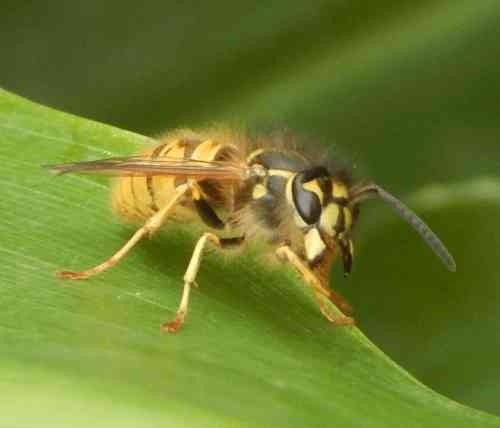Do Bees Eat Meat? Amazingly, A Small Group Of Tropical Bees Do!
The short answer is:
Although it is very uncommon and the vast majority of bees eat nectar and pollen, a very small number of tropical species of bees (notably
in Panama) do eat meat. These bees are known as 'Vulture Bees'. Furthermore, cannibalism and meat eating have been observed in honey bees and bumble bees from time to time.
Meat-eating bees - 'Vulture bees'
A group of tropical bees, sometimes referred to as 'Vulture Bees', and belonging to the genus Trigona, eat dead animal flesh – which may be rotting - for protein.
Such bees have been observed to eat meat from dead
lizards, toads, birds, dead monkeys and even snakes and fish (not to mention cases where chicken was supplied by the research scientist). They have also been observed to chase away
flies already feeding at a dead carcass1.
Below is a photograph of a species which eats decaying flesh, and in this case, the flesh of a dead lizard.
 Above: Meat eating bees - Trigona hypogea eating a dead lizard. Photograph by D. Wittman
Above: Meat eating bees - Trigona hypogea eating a dead lizard. Photograph by D. WittmanWhilst feeding, they typically attack the dead carcass through the eyes.
The bee feeding at the carcass mixes the animal flesh with a digestive fluid it secretes from its mandibular or salivary glands. This breaks down the flesh into an edible substance, which is then stored in the bee’s ‘crop’.
Back at the nest, this substance is then placed into pot-like containers until it is time to feed the immature bees.
Species known to eat meat include:
- Trigona crassipes (Fabricius, 1793)
- Trigona necrophaga (Camargo & Roubik, 1991)
- Trigona hypogea
- Trigona hypogea robustior (Schwarz, 1948)
- Trigona hypogea hypogea (Silvestri, 1902)
Video Of Vulture Bees Eating Chicken
UCR entomology student, Jessica Maccaro, observes vulture bees feeding on chicken.
Isn't A 'Meat Bee' A Type Of Wasp?
 Yellow jacket wasps are sometimes called 'meat bees' in certain geographical regions.
Yellow jacket wasps are sometimes called 'meat bees' in certain geographical regions.Please note, these carrion bees or meat eating bees, must not be mistaken for the Yellow Jacket wasp that in some regions may be referred to as a 'meat bee', probably because wasps are known to feed other insects (including crop pests) to their young.
Why Do These Bees Eat Meat?
Dr David Roubik found that these bees are not able to access pollen, and the bees had no pollen stores for feeding their young.
Pollen is a very important protein source for developing bees, and hence the meat replaced the protein content other bee species gain from pollen.
You can read more on my page about why bees need nectar and pollen.
How Are These Bees Adapted To Eating Meat?
Dr Roubik found that these meat (carrion) eating bees have five sharp teeth on each mandible (mouth part) with which they can bite into flesh.
Other bee species carry pollen on their hairy bodies, but interestingly, Roubik found these bees had evolved physically, so that they have lost the hairy pollen baskets on their hind legs that most bees use to transport pollen to the nest.
Do other bee species eat meat?
I was surprised to learn of observations from Spain of Bombus terrestris (buff-tailed bumble bee) eating meat. See Do Bumble Bees Eat Meat?
However, cannibalism in honey bees at particular times has long been documented. This topic is explored further on my page: Are Bees Vegetarian?
Do Bees Eat Other Insects?
No they don’t.... at least, not generally! However, again there are exceptions!
One of the Vulture bee species listed above –
certainly Trigona hypogea, has been
observed to eat dead insects.
What Else Do Bees Eat?
Most bees stick to nectar and pollen, however, bees may be observed eating aphid honey dew, secretions from extra-floral nectaries of plants, and sometimes even the juice on ripe fruit such as plums.
You can read more about this on my page: What Do Bees Eat?
Reference
1. Roubik DW. Obligate necrophagy in a social bee. Science. 1982 Sep 10;217(4564):1059-60. doi: 10.1126/science.217.4564.1059. PMID: 17839343.

